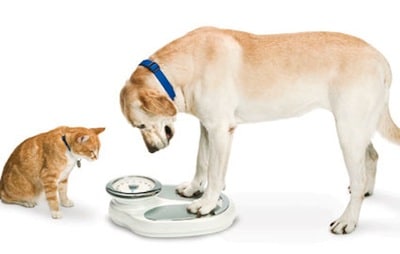Pet Obesity and Its Dangers

Pet obesity is a common problem that can severely affect a pet’s health. Some of the main problems a pet can experience by being obese include:
- Increased risk of cancer and heart disease.
- Arthritis.
- Respiratory issues.
- High blood pressure.
- Shorter life expectancy.
Pet obesity is very common and can contribute to a lot of issues that can affect your pet’s health, well-being and life expectancy. Statistically, 59.5% of cats are obese and 55.8% of dogs are obese. To help prevent obesity in pets, it’s important to feed them the proper diet, make sure they get the adequate amount of exercise each day and manage their caloric intake.
There are many ways to prevent pet obesity, but the most common way to prevent your pet from becoming obese is by managing their caloric intake. When it comes to pet obesity, many people overestimate the effects of exercise. While it’s healthy for your pet to exercise, managing your pet’s diet is the main way to prevent obesity. You can help to manage your pet’s diet by having them follow a strict plan and making sure they’re not consuming too many treats or human foods.
The epidemic of obesity in our nation has received widespread attention in the news in recent years. Obesity has strong correlations to multiple diseases seen in humans. What many people do not realize is that these same conditions and others affect our pets; decreasing their overall quality of life as well as longevity.
Medical conditions related to obesity include the more obvious and common conditions seen in humans. Bone and joint conditions, such as degenerative joint disease (arthritis), ligament injuries (such as cranial cruciate tears) and spinal problems (such as intervertebral disc disease) are seen commonly, and can greatly impact our pet’s quality of life. Chronic pain and debilitation due to mobility problems cause not just physical signs, but can also impact the pets’ mental health. The stress brought about by not being able to move or run free impacts our animal companions on a level different to what a human may experience, purely from an evolutionary standpoint. A dog, for example, typically a mobile predatory species, may feel under constant threat if unable to move adequately or without pain. Constant stimulation of the sympathetic nervous system, the “fight or flight” response is also linked to deteriorating health due heart, kidney and adrenal conditions.
Less commonly thought of conditions related to obesity in our pet species include Diabetes, fatty liver syndrome and chronic kidney disease. Pancreas inflammation (pancreatitis) in dogs and chronic constipation in cats also relates to obesity, and chronic skin conditions are seen in both species. Cognitive decline in older pets is also linked to obesity. Even development of various cancers relates to body fat composition. Excess fat is known to secrete hormones and inflammatory proteins that impact virtually the function of all organs. In essence the presence of extra fat causes stress at a cellular level, decreasing availability of oxygen and increasing the level of toxins that cells are subjected to. Obesity in and of itself is a disease, and needs to be managed as such.
Luckily, obesity management in our pets is simple. Insuring appropriate caloric intake in our animal counterparts is much easier than in ourselves, remembering that it is us who control what they eat. Luckily for us, our pets do not have access to the drive through window, and most lack the dexterity to open the refrigerator or cabinet doors (admittedly, some do open doors, but at least this can be remedied easily through the installation of cabinet locks or simply through restricting access to the kitchen). Caloric intake needs to be based on body size, desired weight, and activity level. Many owners overestimate activity- it’s important to keep in mind that many pets sleep throughout the day when their human is away at work, and that even though daily walks or exercise sessions are great for your pets’ health, the number of calories burned is usually minimal. Spaying and neutering cause a drop in metabolic rate; further decreasing the pet’s overall caloric need. A starting point for determining caloric need is to feed 50 calories per 2 pounds of body weight- for example, for a 50 pound Labrador retriever, this would equate to about 1200 calories per day, whereas for a 10 pound cat, this equates to about 225 calories per day. Many over the counter foods contain a minimum of 400 calories per cup, so it is important to evaluate the caloric content of the diet being fed, and to use a measuring cup to accurately measure the amount of food being fed. The calories in any added treats or human foods need to be subtracted from the total being ingested- keep in mind that even just a few bites of human food or a medium sized dog biscuit can pack a 100 calorie punch, and that over time this will cause weight gain. If the pet is gaining weight on this intake, then cutting back by 25% will help with weight loss. If, after trying strict caloric control, a pet is still having trouble with weight loss, then seeing your veterinarian is recommended. Some pets are affected by thyroid or other conditions that can impact weight, or may need a prescribed diet for weight loss.
Healthy weight impacts so many aspects of our pets’ life and longevity. Please contact us with any questions as we strive to give your pet the healthiest life possible.




